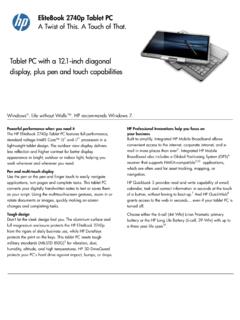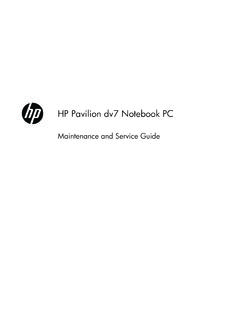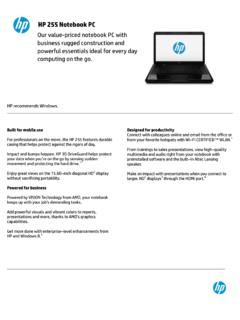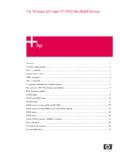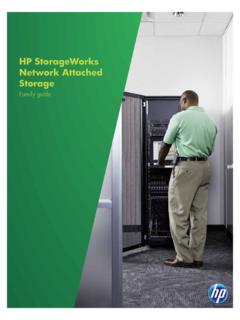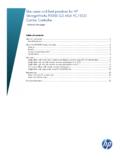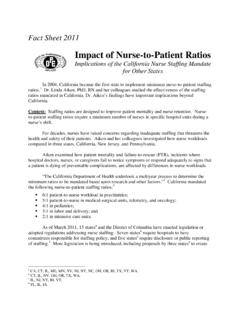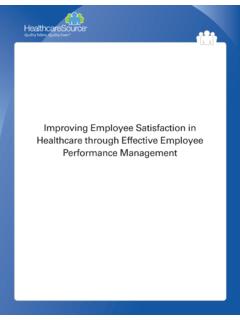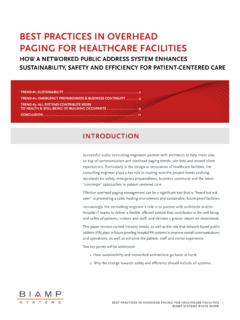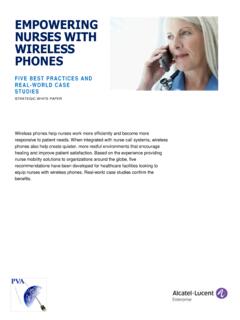Transcription of Technical White paper Healthy, wealthy and wise - …
1 Technical White paperHealthy, wealthy and wiseReal-time intelligence helps match beds and patients for better care, for more people, at less | December, 2012 Table of contents1 Fixed beds, moving patients Urgency and quality of care Financial and regulatory drivers2 Better communication and coordination Symptoms of poor patient flow3 From bed management to patient placement The promise of all-digital technology4 Transforming the hub of patient flow Before Now5 Informing management decisions Before Now6 The numbers tell the story7 Real-time visibility and workflow considerations8 Do no harm: Best practice patient placement principles9 Ready-to-go real-time patient flow from the leaders in healthcare technology Central Logic Core bed management software HP TouchSmart workstations, PCs, tablets, and interactive digital displays 3rd-generation Intel Core vPro processor technology10 Getting started Financing Consulting11 Learn more About HP About Central Logic About IntelTechnical White paper | Solution3 | December, 2012 Better patient flow, better patient experienceHospitals are recognizing that better patient flow management improves quality of care, resource utilization, and cost-efficiency.
2 The 2012 Patient Flow Challenges Assessment survey conducted by American Hospital Association (AHA) solutions and Hospitals in Pursuit of Excellence (HPOE) finds hospitals investing in patient flow improvement initiatives that span process, staffing, and systems and reporting positive results from their According to Tony Burke, CEO of AHA solutions , Patient flow directly impacts a health care facility s overall performance and can also play a strong role in patient satisfaction. 2 Fixed beds, moving patientsPatient flow management starts with the earliest point in patient transport whether a patient comes in through, ER, OR, Dialysis, or another health system through the patient s discharge, whether to another care facility or their own home. A hospital s ability to manage patient flow depends on its ability to balance both demand (patient needs) and supply (finite physical and human care resources).
3 At the core of patient flow is bed management, or capacity management. Patient transfer, for example, is operationally inseparable from capacity management, because proper patient placement depends on what beds are available. Gaps, delays, or mistakes in placing patients in the right bed, with the right level of care, can have serious negative clinical, operational, and financial impacts. Making the best use of existing hospital resources is critical in light of economic uncertainties coupled with the anticipated growth in demand from an aging population and the newly insured under healthcare reform. Even a small improvement in efficiency in patient placement and flow can have significant impact. For example, reducing average length-of-stay by just four hours in a 275-bed hospital is the equivalent to increasing the facility s physical capacity by 10 and quality of careCapacity management is much more than just the timely allocation and provisioning of physical beds.
4 Urgency and quality of care requires that patients be matched with the right bed with the right level of nursing care and access to the right specialists, diagnostics and treatments as quickly as Source AHA solutions and Hospitals in Pursuit of Excellence (HPOE). Results and Report of the 2012 Patient Flow Challenges Assessment: Hospitals Consider Patient Flow Essential to Care and Competitiveness. 2012 2 Source AHA solutions press release, January 26, 2012. 3 Source CSC calculation based on CDC data on averages for inpatient care (non-Federal short-stay hospitals) White paper | SolutionThe timeliness of definitive care is the most critical and complex aspect of patient placement, directly impacting the quality of care and patient experience. According to State-led initiatives like the nurse-to-patient ratios mandate initiated in 1999 in California, critical care beds in the ICU and step-down units require a 1:1 nurse/patient ratio, while standard care is 1:3, and general medical and surgical units only require a 1:5 no suitable bed is available or the transfer center is unable to see that such a bed is available an admitted patient may need to be placed in another, less suitable area of the hospital, and subjected to multiple moves.
5 For example, an oncology patient may first be transferred to a bed in the pediatric surgery ward, or vice versa. In a worst case scenario, admission may be delayed and critically ill patients are boarded in an emergency department or hallway until a bed opens with the proper level of patients into the right bed, the first time, improves health outcomes and patient experience, and reduces overall length of stay. The ability to make fast, informed decisions about patient placement from transfer, admission, and internal transport, to discharge is an important factor in achieving many hospital objectives, including higher Hospital Consumer Assessment of Healthcare Providers Systems (HCAHPS) survey ratings, reducing unnecessary re-admissions, and making the most efficient use of all health system resources. Financial and regulatory driversProper and efficient patient placement also contributes to lower costs for patients , payors, and hospitals.
6 Medicare, Medicaid, and private insurers closely monitor right patient status as designated by the patient s physician and compare intensity of service and severity of order to define reimbursable patient stay. If, for example, a patient comes to the ER with abdominal pain, it could be appendicitis, but initial lab work and symptoms are not definitive. The insurer will typically pay the full cost of overnight observation. However, if the patient is unnecessarily admitted the next day due to inappropriate communications to the care team to ascertain status, the insurer may not pay the full cost, leaving the hospital to absorb the reform will increasingly tie reimbursement to hospital quality of care metrics such as HCAHPS and other still-to-be defined efficiency measures. Beginning October 2012, hospitals faced maximum financial penalties of up to 1% of Medicare/Medicaid reimbursement for excessive readmission of patients in less than 30 days.
7 In 2014, the maximum financial penalties double to 2% of Medicare/Medicaid financial benefits of being able to quickly, efficiently place patients in the right bed the first time are compelling. They include: Added capacity Without physically expanding, through more efficient utilization and faster turnover of existing capacity and less bed hiding from delayed updating of availability Increased revenue By providing care for more patients , without adding resources Reduced costs By optimizing use of hospital resources and proactively managing length-of-stay Improved staff productivity By cutting the time teams (transport, emergency, transfer, nursing, EVS) spend looking for data and minimizing work queuing Improved patient health and satisfaction By reducing wait times and timeliness of definitive care Shorter length-of-stay / Fewer readmissions Through right level of care and coordinated discharge processes4 | December, 2012 Technical White paper | Solution4 Source Health Affairs September 2002 vol.
8 21 no. 5 53-64: Source communication and coordinationTo achieve the full clinical, operational, and financial benefits of better, faster patient placement, hospitals must be willing to address significant challenges chiefly, the conundrum of how to improve communication and coordination among extremely busy professionals engaged in different, but critical tasks. Indeed, percent of the hospital leaders surveyed for the Patient Flow Challenges Assessment report, identified poor communications as the root cause of poor patient number of factors contribute to the sharing of timely and accurate information required for fast, smart bed management decisions and efficiencies. These include: Constant changes in bed and patient status Separate admission processes and systems in different departments ( , emergency, cardiology, pediatrics, obstetrics) Manual data entry and reconciliation, decreasing staff productivity and increasing risk of errors Multiple, incompatible sources and versions of information on bed status and patient needs in multiple, incompatible data formats ( paper , whiteboard, Excel files, ADT, Electronic Medical Records (EMRs), patient transfer and EVS worklists)
9 Difficulty of inputting and accessing information at the point of patient care Need for strict security and privacy in compliance with HIPAA and other regulations and policies to protect access to, and update of, patient information No ability to capture and analyze or review data to measure performance/quality, identify trends or target areas for improvement Symptoms of poor patient flow A quick check to determine flow issues would be to ascertain if any of these circumstances are recurring: Holding patients overnight in the ER who need to be admitted Full recovery room (PACU) results in delayed OR procedures Turning patients away due to inefficient inpatient capacity managementFrom bed management to patient placementTraditionally, bed management solutions for managing information and communications have focused on turning over physical beds as quickly as possible, primarily by helping Environmental Services (EVS) teams schedule and report on room cleaning, with little matching of patient needs and levels of care and services.
10 Such solutions , whether internally developed or purchased from a vendor, have typically only exacerbated communication , complexity, and cost issues by adding to: The number of incompatible systems The amount of data created The number of places data is stored IT maintenance expenses staff training requirementsThe promise of all-digital technologyToday, advances in digital technology enable a new approach: patient-centered placement. In this setting, resources are organized around patient needs and all teams (transport, ER, ADT, clinicians, EVS) share real-time visibility into the patient s needs and status through advances in processors, touch-enabled devices, and Web-connected application technologies make it increasingly practical for hospitals to implement end-to-end digital solutions that provide everyone on the patient care team with the real-time, at-their-fingertips information they need to make patient placement | December, 20126 Source AHA solutions and HPOE.
